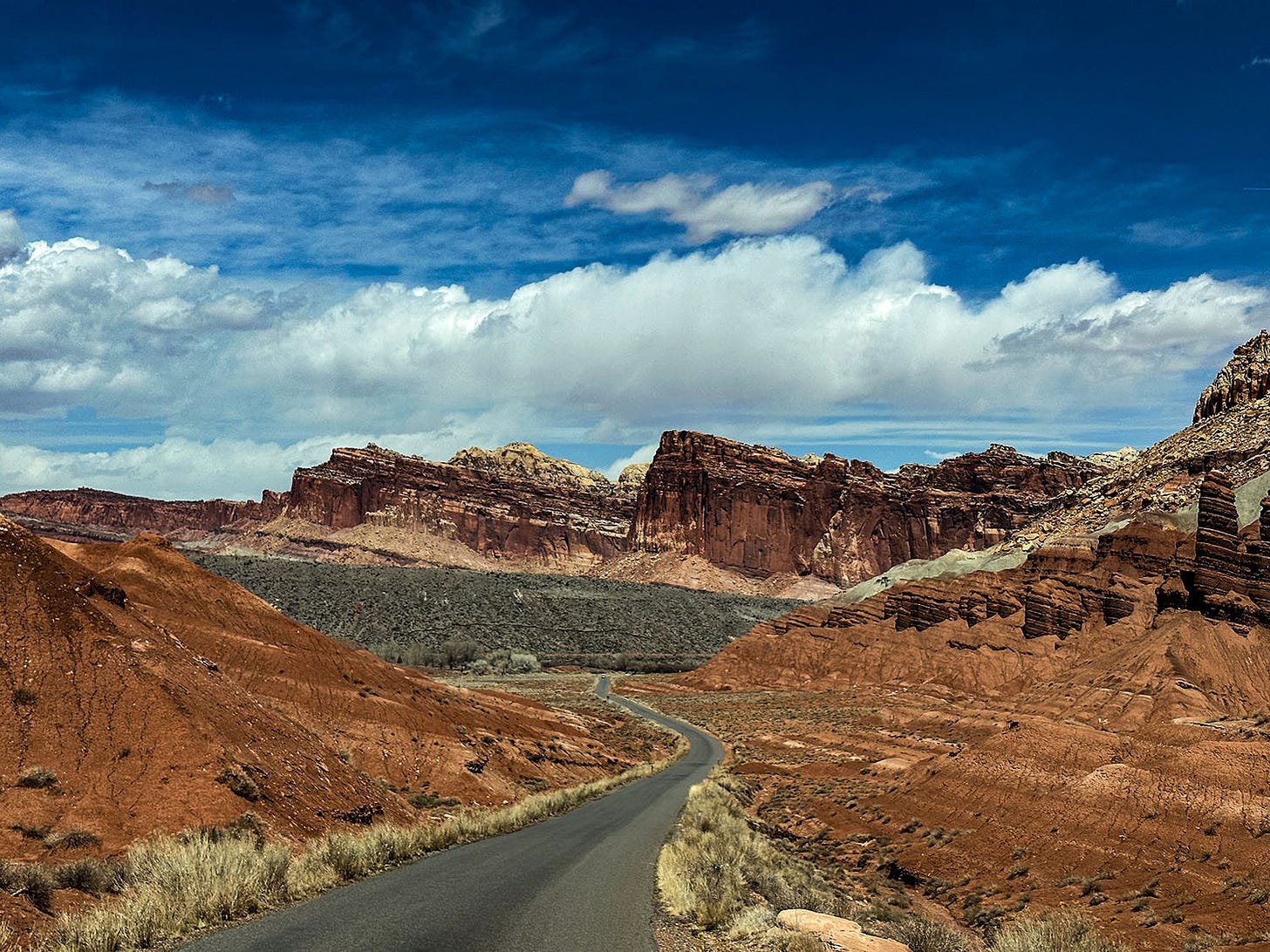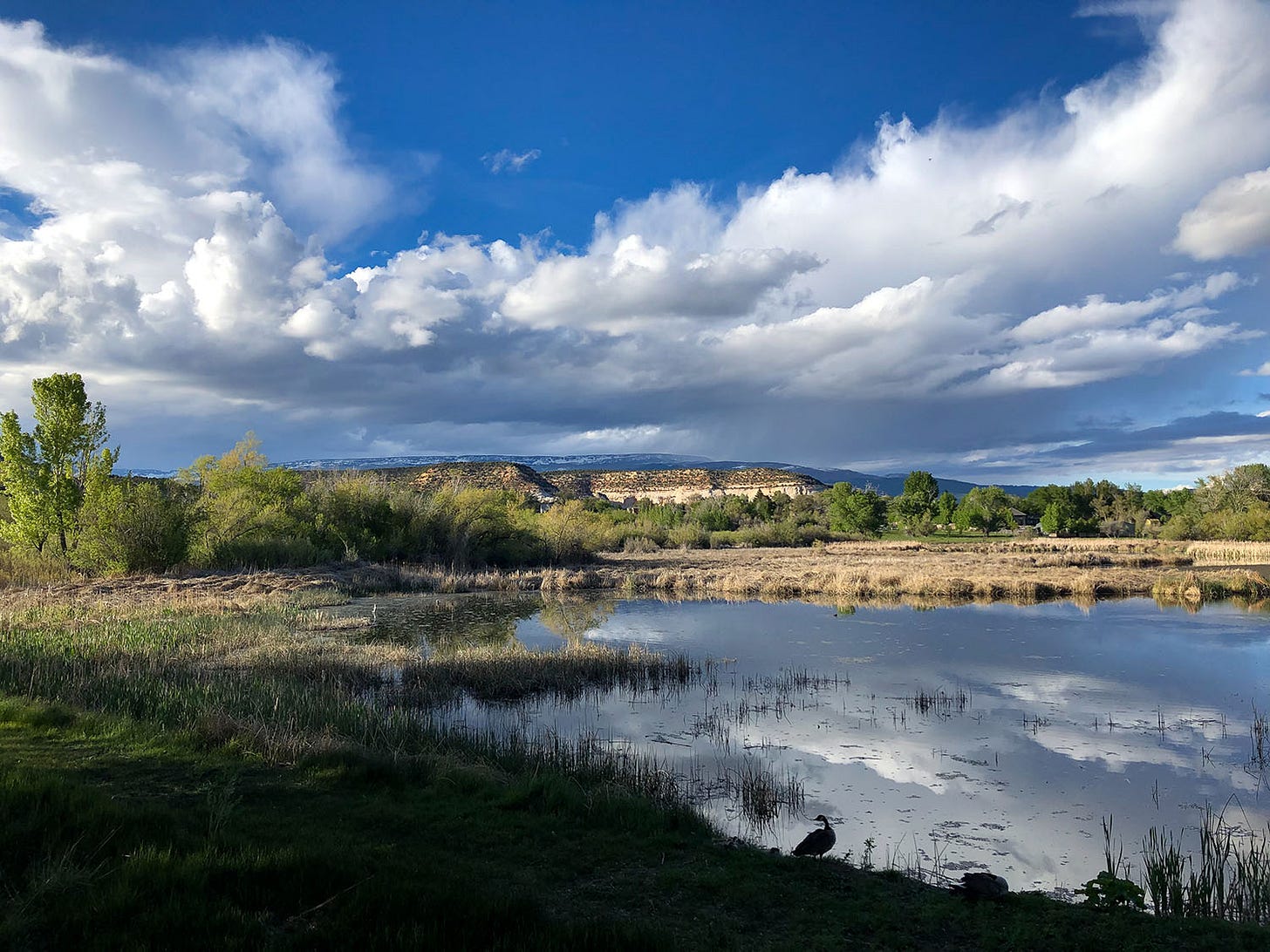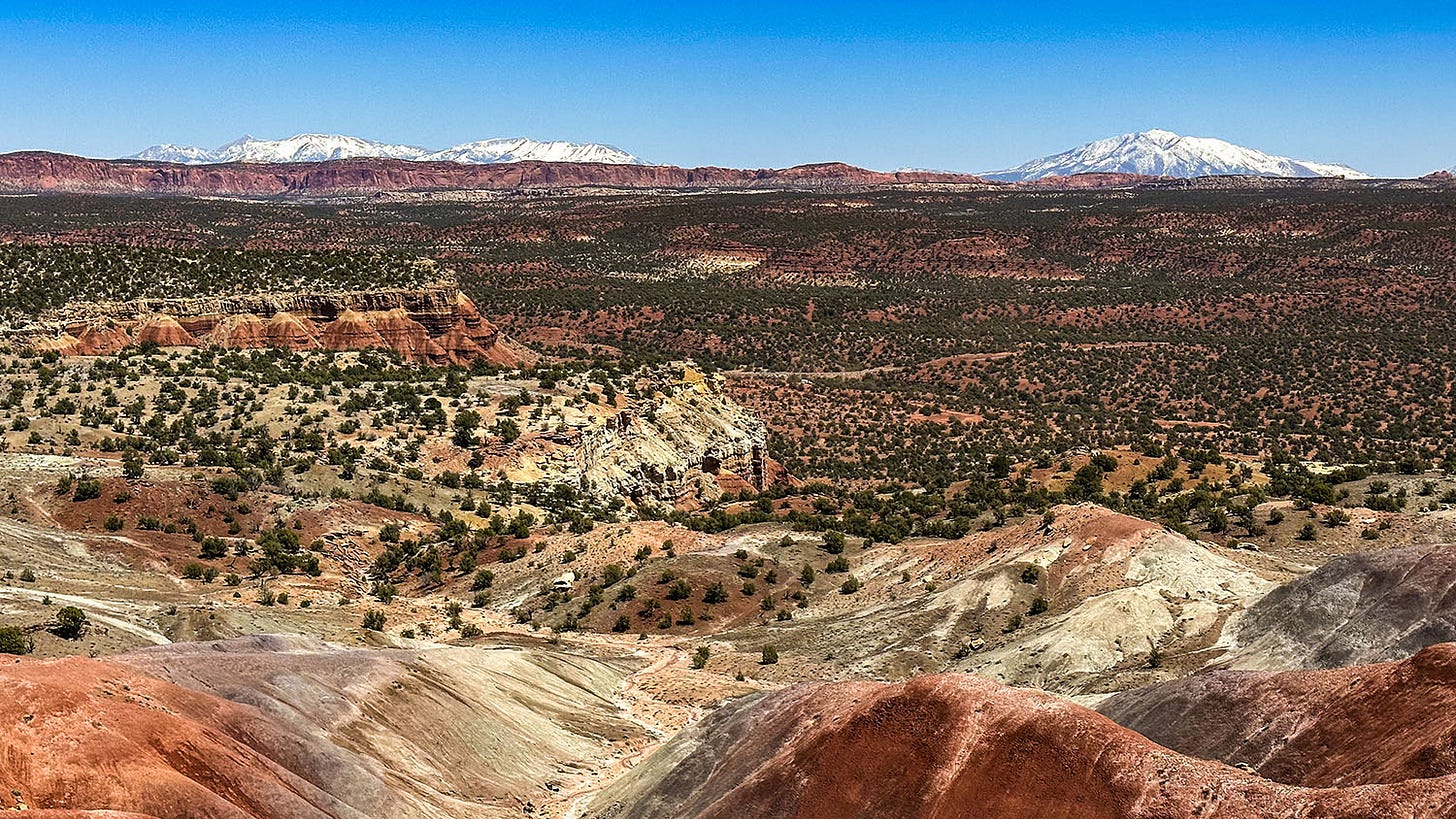On the first night of our pilgrimage, we camped on the bottom of Lake Mead.
No, our Next Chapter adventure van does not have Submarine Mode as an option. But there were freshwater clam shells scattered among the rocks, sand, gravel and silt of the bone-dry boondocker site in Nevada’s Lake Mead National Recreation Area where Leslie and I camped in April. Erosional terraces on surrounding slopes indicated the levels of former lakeshores above our heads.
According to my GPS app, our camp’s elevation was 1,175 feet above sea level. Lake Mead’s highest surface elevation, which it reached in the extraordinarily wet El Niño year of 1982-83, was 1,225 feet. At that level, our campsite would have been under 50 feet of water.
The lake surface has not reached that 1983 level again. As of the end of March 2023, the surface elevation stood at 1,046 feet, storage in the nation’s largest reservoir having steadily dwindled over the past four decades to less than 30 percent of its designed capacity. The last time the lake would have been deep enough to lap at the site of our camp was February 2002, according the U.S. Bureau of Reclamation’s records.
On that April night in our campsite, our first on a two-week road trip, we enjoyed a desert sunset and watched a steady stream of aircraft on approach to nearby Las Vegas International Airport. An arm of the lake was within sight, maybe a half a mile away. Walking distance, had we been so inclined.
We were not. In one sense, Lake Mead NRA was merely a convenient overnight stop on our way to Boulder, Utah, and the true object of our springtime pilgrimage: Hell’s Backbone Grill, a James Beard-nominated restaurant in the unlikeliest of settings, with the most improbable of origin stories. We weren’t in Nevada to explore, just to sleep. Still, for a water-policy geek like me, it was hard not to be drawn by our view of the lake into contemplation of the slow-motion catastrophe that is management of the Colorado River watershed.
The last drop
It had been 20 years since my last visit to Lake Mead, which together with its upstream neighbor, Lake Powell, impounds the Colorado River to keep the southwestern United States alive — all of it, cities, suburbs, farms, factories, a region of 40 million people — by delivering water and electricity. I last traveled there in 2003 while working on a series of newspaper stories titled “The Last Drop: Water in the West,” an award-winning reporting project that took me from the Colorado River’s ultimate headwaters in Wyoming to its delta in the Gulf of California, as well as to many other flashpoints of conflict over an increasingly overtapped resource throughout the region.
An aside:
Sorry, my Coloradoan friends and relatives — Wyoming, not Colorado, should rightfully be regarded as the river’s true source. The only reason the Colorado River extends into the Colorado Rockies today is because the state’s Congressional delegation meddled a century ago in the formal process of standardizing the nation’s geographic nomenclature.
Until 1921, the Colorado River by that name began in Utah, at the point where its two largest tributaries — the Green River and the Grand River — met inside what is now Canyonlands National Park. By tradition, the headwaters of the longest of these, the Green (more than twice as long as the Grand), was considered the ultimate origin of the Colorado.
That pissed off Colorado Congressman Edward Taylor to no end. Normally, assigning names to rivers and other features is the purview of the little-known U.S. Board on Geographic Names. But after a decade of agitation, Taylor formally petitioned Congress in 1921 to rename the Grand the Colorado, and Congress ultimately complied, despite grumbling from the Wyoming and Utah delegations.
End of digression.
With lakes Mead and Powell both at dangerously low water levels — nearing the point at which they will no longer be capable of generating hydroelectricity or releasing water to maintain flows downstream — there has been no shortage of media coverage about a looming crisis on the Colorado.
Such coverage almost always points to the ongoing 20-plus-year drought in the Colorado watershed as a major cause of this problem. But although it is true that drought has exacerbated the situation, the root cause lies in the original sin of Colorado River management: The Compact of 1922, which apportioned the river’s flows among the seven states in its watershed.
Relying on a paltry 18 years of data, a multi-state delegation of negotiators concluded that the reliable average flow of the river past the magic marker of Lee’s Ferry, Arizona, was 16.4 million acre-feet annually (an acre-foot equals 325,900 gallons and is about what two average Southern California households use in a year). The agreement, which was intended to settle a morass of legal and legislative battles, divided the Colorado watershed into an Upper Basin and a Lower Basin, declared an average of 15 million acre-feet to be available for withdrawal each year, and granted half of that to the upper basin states of Wyoming, Colorado, New Mexico and Utah, and half to the lower basin states of California, Nevada and Arizona.
The negotiators were working with the best data available at the time. Problem was, the data reflected an anomalously wet 18 years in the long, dry history of the semi-arid West, and the ensuing century-plus has demonstrated just how wrong their original assumption was. A logical approach to river management would have recalibrated the states’ water allocations over time as more data made clear just how much lower the long-term flow truly is — 12.4 million acre-feet on average, and even less during droughts (which are likelier to be the norm than the exception in a warming climate). But that did not happen.
Despite the fact that lakes Mead and Powell have been steadily shrinking for 40 years, little progress has been made in resolving this fundamental problem: The river has been vastly over-allocated to water interests that now bicker endlessly over how much of their illusory share of this resource they should give up to bring natural supply and human demand into balance.
So, the lakes shrink and the Colorado dwindles. I’ve ridden the rapids of that great river the length of the Grand Canyon, and the even more rambunctious upper stretch of whitewater through Cataract Canyon, which is just downstream from where the Old Colorado once began — the confluence of the Green and the no-longer Grand. In addition to the looming economic catastrophe a dead-pool reservoir would be, it is heartbreaking to contemplate the possibility that the current generation of Colorado River guides may be the last to know what it was like to pilot small boats through giant waves downstream of the concrete plugs that natural forces and human stubbornness may soon turn into dead-end traps for an overtapped river.
A culinary oasis in the desert
From Lake Mead, we skirted Las Vegas and headed for Boulder, Utah, on a route that carried us through Panguitch, Tropic and Escalante. All are in various stages of evolution from small rural towns reliant on ranching and mining to tourism-friendly New West economies driven by the growing popularity of relatively new recreation meccas in the Southwest, mainly the sprawling Grand Staircase-Escalante National Monument.
Established by presidential proclamation in 1996 (the Clinton administration), reduced in size by half in 2017 (Trump), and restored to its original boundaries in 2021 (Biden), it’s 1.9 million acres of redrock splendor, a wonderland of canyons, mountains, desert rivers, archaeological treasures, long views and profound silences.
Boulder is on its doorstep. The Mormon ranching town of about 250 people also lies at the intersection of two of the most beautiful roads in the West: Utah Highway 12, which connects Escalante and Boulder with 24 miles of sinuous, vertiginous asphalt; and the Burr Trail Road, which slices through spectacular slickrock country for 36 miles on its way to Capitol Reef National Park and a plunging, unpaved, switchback descent 800 vertical feet down the eastern face of the mind-boggling Waterpocket Fold.
When we arrived, we checked in at the Boulder Mountain Lodge, one of the few accommodations in the area and fortunately a lovely place to stay, and then made our way to Hell’s Backbone Grill for dinner. We try to stop there every time we are in this part of Utah, drawn both by the fantastic cuisine and by the life-affirming story of how it came to be and how it has persevered. Our timing doesn’t always work out — the restaurant is only open from roughly March through November, closing when winter drops a blanket of frigid air and snow over the high desert, and chases off the visitors. We’ve missed opening day more than once.
But not this year. We spent two nights at the lodge, and ate dinner at the restaurant (which shares the same grounds) both nights. On our layover day, we hiked into Grand Staircase-Escalante to a spectacular waterfall on Lower Calf Creek, picnicking amid leafless cottonwoods that had not yet responded to the springtime weather.
Chef-owners Blake Spaulding and Jen Castle founded Hell’s Backbone Grill more than two decades ago, drawn to Boulder by the staggering beauty of the surrounding landscape. Establishing a fine-dining outpost in one of the most remote towns in America was, to put it mildly, a gamble. There are no commercial food and equipment suppliers there, no trained restaurant workforce, no built-in customer base of foodies. And they also vowed to operate their business on Buddhist principles, with a commitment to sustainability, environmental ethics, and community responsibility.
Boulder did not know what to make of the newcomers when they launched their quixotic undertaking. The community is deeply conservative, suspicious of outsiders, and at the time was seething with anger over the recent monument proclamation, which many residents feared would disrupt their way of life. Blake and Jen, on the other hand, were counting on the monument’s newfound celebrity to draw the outside visitors who would be crucial for the restaurant’s survival. That collision of perspectives set the stage for potentially unresolvable conflict.
The story of how the two women won over the town, turned Hell’s Backbone Grill into one of the best restaurants in the country, and created a spiritual bridge in Boulder between insiders and outsiders, is told beautifully in their first cookbook: With a Measure of Grace: The Story and Recipes of a Small Town Restaurant. I highly recommend it, for the stories as much as for the recipes. (Although, trust me, you are going to want to make Spicy Cowgal Meat Loaf with Backbone Sauce and Blue-Ribbon Black-Powder Buttermilk Biscuits.)
The restaurant was a James Beard Award semifinalist in 2017, 2018 and 2019, a finalist in 2020, and a semifinalist in the “Outstanding Restaurant” category in 2022 and in 2023. It was also voted “Best Restaurant of the Rockies” by Elevation Outdoor Magazine, and was named “Best Restaurant in Southern Utah” by Salt Lake Magazine from 2007 to 2019 (and it now resides in the magazine’s Hall of Fame). It was presented the Utah Governor’s Mansion Award for Culinary Artistry in 2006. The restaurant sources produce from its own small farm, fruit from local heirloom orchards, meat from local ranchers, and focuses on seasonal, regional fare.
With a résumé like that, you might think its financial fortunes would be secure. But you’d be wrong.
Like restaurants everywhere, Hell’s Backbone Grill was walloped by the COVID pandemic. Having barely survived that ordeal, it found itself on even shakier ground when southern Utah tourism plummeted in the summer of 2022, for reasons that are unclear. Struggling to pay off the debt incurred to remain open during the COVID emergency, Blake and Jen warned in their newsletter last fall that they may not be able to reopen in spring 2023 for their 24th season. They also reluctantly launched a GoFundMe campaign to see if they could stave off a demise that seemed increasingly inevitable.
It was not. Their initial goal of $324,00 was easily met and surpassed within days, an outpouring of financial and emotional support from fans and customers all over the country (including Leslie and me) that left them staggered and grateful beyond words.
As a storyteller myself, I’m a sucker for a good tale, and I am inspired by the story of HBG’s founding; the bold courage of its owners in the face of hard times, suspicion and outright hostility; and their creation of a community that encompasses not just tiny Boulder but friends and fans across this entire country. The spectacular setting of southern Utah’s redrock landscape has too often been a battleground, where those who love it for its beauty, wildness and rich history face off with those who see it only as a storehouse of resources to be exploited. Blake and Jen found a path to grace and fellowship amid the confrontations, crafting a story worthy of the landscape while serving up delicious, creative food.
We can’t wait to read their next chapter. Or to eat our next meal at their table.










Ahhh thanks again for a great recap of your travels. Love the photos too!
Jill